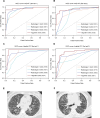Novel 3D-based deep learning for classification of acute exacerbation of idiopathic pulmonary fibrosis using high-resolution CT
- PMID: 38460976
- PMCID: PMC10928777
- DOI: 10.1136/bmjresp-2023-002226
Novel 3D-based deep learning for classification of acute exacerbation of idiopathic pulmonary fibrosis using high-resolution CT
Abstract
Purpose: Acute exacerbation of idiopathic pulmonary fibrosis (AE-IPF) is the primary cause of death in patients with IPF, characterised by diffuse, bilateral ground-glass opacification on high-resolution CT (HRCT). This study proposes a three-dimensional (3D)-based deep learning algorithm for classifying AE-IPF using HRCT images.
Materials and methods: A novel 3D-based deep learning algorithm, SlowFast, was developed by applying a database of 306 HRCT scans obtained from two centres. The scans were divided into four separate subsets (training set, n=105; internal validation set, n=26; temporal test set 1, n=79; and geographical test set 2, n=96). The final training data set consisted of 1050 samples with 33 600 images for algorithm training. Algorithm performance was evaluated using accuracy, sensitivity, specificity, positive predictive value, negative predictive value, receiver operating characteristic (ROC) curve and weighted κ coefficient.
Results: The accuracy of the algorithm in classifying AE-IPF on the test sets 1 and 2 was 93.9% and 86.5%, respectively. Interobserver agreements between the algorithm and the majority opinion of the radiologists were good (κw=0.90 for test set 1 and κw=0.73 for test set 2, respectively). The ROC accuracy of the algorithm for classifying AE-IPF on the test sets 1 and 2 was 0.96 and 0.92, respectively. The algorithm performance was superior to visual analysis in accurately diagnosing radiological findings. Furthermore, the algorithm's categorisation was a significant predictor of IPF progression.
Conclusions: The deep learning algorithm provides high auxiliary diagnostic efficiency in patients with AE-IPF and may serve as a useful clinical aid for diagnosis.
Keywords: Imaging/CT MRI etc; Interstitial Fibrosis.
© Author(s) (or their employer(s)) 2024. Re-use permitted under CC BY-NC. No commercial re-use. See rights and permissions. Published by BMJ.
Conflict of interest statement
Competing interests: None declared.
Figures





Similar articles
-
Deep learning for classifying fibrotic lung disease on high-resolution computed tomography: a case-cohort study.Lancet Respir Med. 2018 Nov;6(11):837-845. doi: 10.1016/S2213-2600(18)30286-8. Epub 2018 Sep 16. Lancet Respir Med. 2018. PMID: 30232049
-
Multi-scale, domain knowledge-guided attention + random forest: a two-stage deep learning-based multi-scale guided attention models to diagnose idiopathic pulmonary fibrosis from computed tomography images.Med Phys. 2023 Feb;50(2):894-905. doi: 10.1002/mp.16053. Epub 2022 Nov 5. Med Phys. 2023. PMID: 36254789 Free PMC article.
-
Development and validation of a CT-based deep learning algorithm to augment non-invasive diagnosis of idiopathic pulmonary fibrosis.Respir Med. 2023 Nov-Dec;219:107428. doi: 10.1016/j.rmed.2023.107428. Epub 2023 Oct 13. Respir Med. 2023. PMID: 37838076
-
Acute Exacerbation of Idiopathic Pulmonary Fibrosis.Medicina (Kaunas). 2019 Mar 16;55(3):70. doi: 10.3390/medicina55030070. Medicina (Kaunas). 2019. PMID: 30884853 Free PMC article. Review.
-
Diagnosis accuracy of machine learning for idiopathic pulmonary fibrosis: a systematic review and meta-analysis.Eur J Med Res. 2025 Apr 15;30(1):288. doi: 10.1186/s40001-025-02501-x. Eur J Med Res. 2025. PMID: 40235000 Free PMC article.
Cited by
-
Radiomics-Based Artificial Intelligence and Machine Learning Approach for the Diagnosis and Prognosis of Idiopathic Pulmonary Fibrosis: A Systematic Review.Cureus. 2025 Jul 7;17(7):e87461. doi: 10.7759/cureus.87461. eCollection 2025 Jul. Cureus. 2025. PMID: 40772136 Free PMC article. Review.
References
MeSH terms
LinkOut - more resources
Full Text Sources
